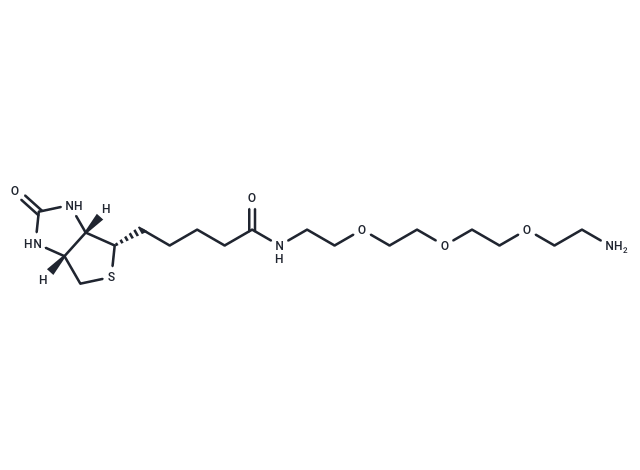Shopping Cart
Remove All Your shopping cart is currently empty
Your shopping cart is currently empty
Amine-PEG3-Biotin can be used as a signal amplification label.

| Pack Size | Price | USA Warehouse | Global Warehouse | Quantity |
|---|---|---|---|---|
| 10 mg | $30 | - | In Stock | |
| 25 mg | $43 | In Stock | In Stock | |
| 50 mg | $58 | In Stock | In Stock | |
| 100 mg | Preferential | - | In Stock |
| Description | Amine-PEG3-Biotin can be used as a signal amplification label. |
| Cell Research | 1. Binding to biological molecules 1. Labeling reaction: Amine-PEG3-Biotin reacts with the target biological molecule, usually by amidation reaction to connect the dye molecule to the target molecule. Depending on the desired labeling effect, the reaction conditions, such as pH, reaction time and temperature, may need to be optimized. 2. Purification of labeled molecules: After the reaction is completed, unreacted biotin is usually removed by dialysis or chromatography. 3. Detection: Detection is performed using streptavidin-enzyme or streptavidin-fluorescent markers to amplify the signal for analysis. 2. Western Blot and immunoassay 1. Labeling antibodies: Enhance the detection sensitivity by labeling Amine-PEG3-Biotin with primary or secondary antibodies. 2. Detection: The labeled antibody is used for protein transfer and detection is performed using streptavidin-enzyme or streptavidin-fluorescent markers. 3. Signal amplification: The strong binding of biotin to streptavidin enables the signal to be amplified, improving the sensitivity of immunoassay. III. ELISA (Enzyme-Linked Immunosorbent Assay) 1. Coating: Coat the biotin-labeled target molecule onto the ELISA plate (such as a labeled antibody or antigen). 2. Detection: Detection is performed by adding streptavidin-enzyme conjugates and generating color or signal through substrate reaction. IV. Cell experiment 1. Labeling cells: Add Amine-PEG3-Biotin to the cell culture medium and incubate for a certain period of time (usually 30 minutes to 1 hour). 2. Washing: Wash away unbound dye with PBS. 3. Fluorescence microscopy: Use a fluorescence microscope or flow cytometer for detection to observe the staining pattern and dynamic process of the cells. |
| Molecular Weight | 418.55 |
| Formula | C18H34N4O5S |
| Cas No. | 359860-27-8 |
| Smiles | C(CCCC(NCCOCCOCCOCCN)=O)[C@H]1[C@@]2([C@](CS1)(NC(=O)N2)[H])[H] |
| Relative Density. | 1.166 g/cm3 (Predicted) |
| Color | Yellow |
| Appearance | Viscous |
| Storage | keep away from direct sunlight | store at -20°C | Shipping with blue ice/Shipping at ambient temperature. | |||||||||||||||||||||||||||||||||||
| Solubility Information | H2O: 95 mg/mL (226.97 mM), Sonication is recommended. DMSO: 245 mg/mL (585.35 mM), Sonication is recommended. | |||||||||||||||||||||||||||||||||||
Solution Preparation Table | ||||||||||||||||||||||||||||||||||||
H2O/DMSO
| ||||||||||||||||||||||||||||||||||||
| Size | Quantity | Unit Price | Amount | Operation |
|---|

Copyright © 2015-2025 TargetMol Chemicals Inc. All Rights Reserved.